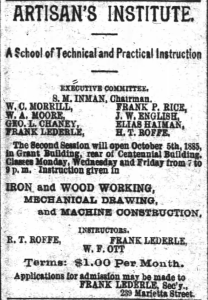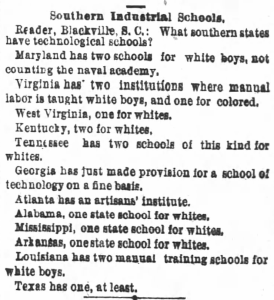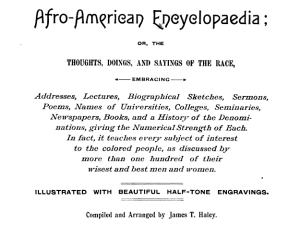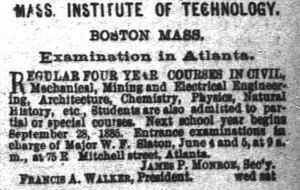Rev. Chaney and the Georgia Institute of Technology
Legend or Lore
Among the Atlanta accomplishments attributed to the Rev. George L. Chaney, founder of the first Unitarian church in Atlanta in 1883, is his role in the establishment of the Georgia Institute of Technology.
From an obituary published in the Christian Register on June 8, 1922, it was observed by, “Mr. Lawrence S. Brigham, who had known Mr. Chaney both in Boston and in the South, spoke warmly of his arduous work, and the beauty of his genial and self-sacrificing character, calling attention especially to his agency in founding the Georgia Institute of Technology, and his self-sacrificing work in establishing the Unitarian church in Atlanta.”
However, no other contemporary obituaries make any reference to Rev. Chaney and the Georgia Institute of Technology.
In a 1954 biography of Rev. Chaney Heralds of a Liberal Faith published by Beacon Press, it was noted, “He there (Atlanta) applied the same educational methods which he had used in Boston and began an “Artisans’ Institute” in connection with his church. This was the seed from which sprung the Georgia School of Technology in Atlanta.”
Roots of the Georgia Institute of Technology
It is not disputed that the Georgia Institute of Technology, initially known as the Georgia School of Technology, was established October 13, 1885 by an act of the Georgia legislature. The bill to establish the school was introduced by Nathaniel Harris, a state legislator from Macon. The legislation did not, however, establish the location of the new technology school. (1) Petitions from Macon, Columbus, Athens, Milledgeville, Atlanta and other cities to the state legislature to establish the school in their city continued into late 1886.
From the period leading up to the introduction and passage of the legislation and during the subsequent lively conversation about the location of the school as documented in Atlanta’s contemporary papers, there is no mention of Rev. Chaney in the news accounts.
In fact, due to his wife’s ill health, Rev. Chaney was absent from Atlanta for a part of the school’s location discussions in early 1886. When he returned to Atlanta in May 1886 (2), his sermons such as “All Flesh is Grass, but the Mercy of the Lord is Everlasting to Everlasting”(3), “The Patriotism of Jesus” (4) and “Grace in the Wilderness” (5) are pastorate and not aimed at securing Atlanta as the location of the new technology school. As debate on the school’s location intensified in 1886, Rev. Chaney departed Atlanta in August for his summer vacation and to attend a Unitarian conference in Saratoga, NY. (6)
Rev. Chaney’s Educational Credentials
Chaney arrived in Atlanta in early 1882 after a fifteen-year ministry at the Hollis Street Church in Boston with undeniable educational bona fides. He had established the Hollis Street Whittling School for the teaching of industrial woodworking skills, served for 12 years as a member of the Boston School Committee and was president of Boston’s Industrial School Association.
Just a few months after his arrival in Atlanta, in June 2, 1882 an article appeared in The Constitution entitled, “Hand Education – Should the Hand as Well as the Brain be Educated.” In that article it was observed that “Mr. Chaney is interested in investigating the problem of education in the south and in impressing our educators with the fact that to affect the best results they must combine the practical with the theoretic, the useful with the classical, and the industrial with the ornamental.”
By 1885, Rev. Chaney was well established in the city when discussions on establishing a southern technology school were in full bloom. Projecting that he had involvement in the founding of such a technology school would be consistent with his energies and inclination to foster new institutions.
By 1883, he had founded the first Unitarian church and began service on the boards of trustees for Atlanta University and Tuskegee (Alabama) University.
Artisans’ Institute

Sun, Sep 6, 1885
Proper credit appears due to Rev. Chaney for establishing Atlanta’s Artisans’ Institute around 1883. The Artisans’ Institute, per an advertisement in The Constitution on September 6, 1885, was described as “A School of Technical and Practical Instruction.” The institute listed as its executive committee: S.M. Inman (chairman), W.C. Morrill, W.A. Moore, Geo. L. Chaney, Frank Lederle (secretary), Frank P. Rice, J.W. English, Elias Haiman and H.T. Roffe.
Several of these executive committee members were also active members in the Unitarian church recently established by Rev. Chaney (Morrill, Moore, Lederle and Rice). It may rightly be inferred that Rev. Chaney reprised his Whittling School experience with his new Atlanta Unitarian congregants.

Mon, Nov 16, 1885
In an article in The Constitution on April 19, 1885, regarding the Artisans’ Institute, the paper’s reporter asked how the institute started. Frank Lederle commented, “Dr. Chaney has a great fancy for this sort of education. He was president of the institution in Boston that started the schools there. He conversed with Mr. Elias Haiman on the subject, and at last it was known that Mr. Roffe could conduct the school. A meeting was called and Messrs. S. M. Inman, W. C. Morrill, W. A. Moore, F. P. Rice and J. W. English gave $1,000 to be spent in buying the tools. The teachers agreed to work three months free.”
Another short article in The Constitution (Nov 16, 1885) listing southern industrial schools included the following: “Georgia has just made provision for a school of technology on a fine basis” and “Atlanta has an artisans’ institute.” It appears that in the mind of the public, the new technology school to become Georgia Institute of Technology and Chaney’s Artisans’ Institute were separate entities.
A search of Atlanta papers for references to the Artisans’ Institute after 1885, revealed no further advertisements for the institute.
The search for references to the Artisans’ Institute did reveal that the Georgia Machinery Company (R.T. Roffe, superintendent) which housed the Artisans’ Institute declared bankruptcy. Its assets were sold at public auction on May 4, 1886. (7) It may be assumed that the Artisan’s Institute ceased operations as well.
In His Own Words
Rev. Chaney’s own words on his involvement in the establishment the Georgia Institute of Technology conveyed a mixed message. During archival research three direct comments from Rev. Chaney on his involvement with the Georgia School of Technology have been uncovered.
The first comment is found in his farewell address to his Atlanta congregation published on November 3, 1890. In his farewell remarks, Rev. Chaney reviewed his and the church’s accomplishments. He remarked, “We have had a hand in many of the most useful and humane enterprises started here, during the last decade. The Industrial Home, the Woman’s Exchange, the Home for the Friendless, the Artisans’ Institute which led the way for the School of Technology, the young men’s library, and the projected reform school for youthful criminals are some of the public benefits we have sought to promote.”
Years later in 1916, remarks written by Rev. Chaney recalling his time in the South were read at a meeting of the Southern Conference in Richmond, Va. In those remarks, Rev. Chaney again reflected on topics covered in his farewell address 26 years earlier. “The Artisan’s Institute, which began in our church, laid the foundation for the Georgia Institute of Technology, now the pride and reliance of the State. Atlanta University for the Freedmen added to its curriculum education in handwork in workshop and garden. Our Literature and Art Club and the History Class, now in its thirtieth year, united in the amenities of belles-lettres the people divided by the asperities of party religion. The Home for the Friendless and the Industrial School, with its domestication of the poorer white girls, showed how possible it was to be charitable without the lust for ecclesiastical increase, and the Woman’s Exchange offered to the proudly poor a means of alleviating their poverty without sacrifice of their just pride.”
As noted, the Artisans’ Institute founding can be traced to Rev. Chaney. However, the record regarding the Artisans’ Institute leading the way for Atlanta’s school of technology may have been more of a nod to metaphorical leadership than actual organizational activities. As noted the Georgia Machinery Company that housed the Artisans’ Institute entered into bankruptcy in May 1886 which was several months prior to the resolution of the location of the new Georgia Technology School.
The third direct comment from Rev. Chaney on his involvement with the Georgia School of Technology was found in an article written by the Rev. Chaney entitled “The New South.” This article was published in the November 1891 issue of the New England Magazine. The article, published after Rev. Chaney departed Atlanta, is a lengthy travelogue and review of the recovery progress in the south since the Civil War.
In one reminiscent comment, Rev. Chaney noted, “Continuing our circuit of the city, we find the Hebrew Orphan Asylum, with its beautiful and commodious edifice, the Moreland Park Military academy, and the Georgia School of Technology, a noble institution recently founded by the state and secured to Atlanta by the munificent contributions of its citizens. It has been modeled upon the Worcester Free Institute in Massachusetts, and has had the supervision of some of the teachers from that institution. The writer of this paper toiled up the hill on which this school is placed, on the occasion of its first commencement, in company with a stranger who said, “I little thought when I dragged cannon up this hill twenty-five years ago, that I should live to see a school like this here.” Emphasis on “toil up the hill” added.
Given a post-Atlanta opportunity to reflect directly upon the Georgia School of Technology, Rev. Chaney’s choice to comment on his “toil” to climb the hill on which the school was situated is revealing. With a chance to expand upon the historic record regarding his involvement, Rev. Chaney chose only to reflect upon his attendance at the first commencement.
Thus, six months prior to Rev. Chaney’s departure from Atlanta, we factually know that in the company of a Civil War veteran he labored up the hill to attend the first commencement services of the Georgia School of Technology. Beyond that not much more can be confirmed.
It has already been noted that in news accounts on the legislation founding the technology school in 1885 there are no references to Rev. Chaney. Nor are there any references to Rev. Chaney as Georgia cities vied to have the school located in their municipality in 1866.
Finally, in a review of the news accounts on the formal opening of the technology school on October 6, 1888 (8), Rev. Chaney is not listed in any newspaper accounts. The same is true two years later in June 1890 at the first commencement (9) that was extensively reported in The Constitution.
Conclusion
Whatever involvement Rev. Chaney may or may not have had in the founding of the Georgia School of Technology, later the Georgia Institute of Technology, may be lost to history.
If we draw some inferences from Rev. Chaney’s involvement with other educational institutions (Atlanta University and Tuskegee), it could be concluded that the Georgia School of Technology may not have been his sweet spot.
More research is required to confirm this next observation, but it can be reasonably argued that among the services Rev. Chaney provided to Atlanta University and Tuskegee was access to northern money.
In the same June 2, 1882 newspaper article on Hand Education referenced earlier, Rev. Chaney noted that “gentlemen in charge of the colored colleges here” are enthusiastic about providing practical, technical training to non-whites. Rev. Chaney went on to declare, “Professor Ware, of the Atlanta University, is determined to raise the money this summer and add a department of practical education for both sexes in his university next session. I am  satisfied that I can raise the money for this purpose in Boston, certainly enough to equip the university with tools and the outfit necessary.”
satisfied that I can raise the money for this purpose in Boston, certainly enough to equip the university with tools and the outfit necessary.”
An oblique but consistent observation regarding Booker T. Washington (Tuskegee), Rev. Chaney and northern money is found in the Afro-American Encyclopedia complied by James T. Haley and published in 1895. In the encyclopedia entry on Booker T. Washington we find the following: “Upon reaching Tuskegee he found neither land nor buildings, nothing but the promise of the State to pay $2,000 annually toward the expenses of the school. The school was started in an old church and shanty with thirty students and a teacher.”
Booker T. Washington was an avid fundraiser for Tuskegee “making the acquaintance and securing the confidence of prominent and wealthy people throughout the country.” Among those prominent and wealthy people were the members of the Boston Unitarian Club. Organized on January 26, 1882, the Boston Unitarian Club was an association of 350 Unitarian laymen with Unitarian ministers being eligible for only associate membership. The encyclopedia entry went on to note that the Boston Unitarian Club was the “most intelligent and wealthy club in the world.”
There are also references in Booker T. Washington’s papers and Unitarian records regarding the funding of Tuskegee activities via the Unitarian Frothingham Fund. Rev. Frederick Frothingham of Milton, MA left in his will $20,000 to the American Unitarian Association stating that “the income of which was to be used for all time to promote education among the colored people.”
The Georgia School of Technology also solicited financial subscriptions. However, unlike the education of “colored people” promoted by Rev. Chaney the new technology school would serve a white Southern population and found a ready base of southern support. Rev. Chaney in his New England magazine article earlier referenced confirmed that in his eyes funds for the Atlanta technology school were secured by “munificent contributions of its (Atlanta) citizens.”

Wed, May 13, 1885
Additionally, the establishment of a Georgia technology school was a source of Southern pride providing an alternative to students traveling to northern schools for university studies. Northern money may not have been as welcomed as it was at Atlanta and Tuskegee universities.
By the time of the founding of the Georgia School of Technology, Rev. Chaney was already engaged in educational efforts that would leave a lasting legacy to universities that thrive to this day.
Given this review of contemporary news articles, caution is recommended in “calling attention especially to his agency in founding the Georgia Institute of Technology” or noting that the Artisans’ Institute “was the seed from which sprung the Georgia School of Technology in Atlanta.”
There is no diminishment of the great works of Rev. Chaney if we demur on his role in the formation of the Georgia Institute of Technology. All Atlanta Unitarian Universalists who cross the threshold of their sanctuaries each Sunday have Dr. Chaney to thank for planting their religious faith in Atlanta. This accomplishment is indisputable.
Footnotes:
Archivist Note: Newspaper references in the footnotes may be requested. Contact the Archivist..
1. Who Will Get It? The School of Technology a Precious Prize, The Atlanta Constitution (Atlanta, Georgia) · Tue, Oct 13, 1885
2. “Rev. George Leonard Chaney has returned from Massachusetts”,The Atlanta Constitution (Atlanta, Georgia) · Mon, May 24, 1886 · Page 8
3. Summary of Sermon, The Atlanta Constitution (Atlanta, Georgia) · Mon, Jun 7, 1886 · Page 8
4. Summary of Sermon, The Atlanta Constitution (Atlanta, Georgia) · Mon, Jul 5, 1886 · Page 8
5. Summary of Sermon, The Atlanta Constitution (Atlanta, Georgia) · Mon, Jul 19, 1886 · Page 7
6. Through the City column, The Atlanta Constitution (Atlanta, Georgia) · Sun, Aug 1, 1886 · Page 9
7. Receiver’s Sale The Atlanta Constitution (Atlanta, Georgia) · Sun, Apr 4, 1886 · Page 6
8. The Formal Opening of the Technology School and Transfer to the State, The Atlanta Constitution (Atlanta, Georgia) · Sat, Oct 6, 1888
9. A Brilliant Close. The Commencement Day of the Technology School, The Atlanta Constitution (Atlanta, Georgia) · Thu, Jun 19, 1890 · Page 3